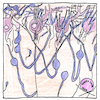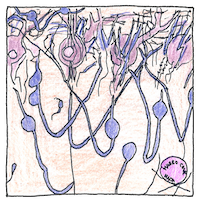Camillo Golgi, Santiago Ramón y Cajal
neuroscience

|
Nervous system
Even given the doctrine that all life is composed of cells gray matter— the tissue of the brain and spinal cord— was difficult to explain. Nerve cell bodies and their delicate and intricate dendrites and axons are more branched than bushes, are more interwoven the fibers of the thread of a spider web. How the parts worked, how they connected, and whether they were all parts of cells could not be distinguished using a microscope. Camillo Golgi discovered a means of staining a limited number of cells in animal tissue at random and in their entirety, so that their soma and their branches are in strong contrast with the background tissues. Santiago Ramón y Cajal used Golgi’s method and experimentally proved nerve cells were not fused together but communicated across touching branches.
Golgi’s method
“fixing silver chromate to the neurilemma by causing silver nitrate to react with potassium dichromate” to stain random cells black. Why this works for cells at random has not been explained. Why some things work sometimes and not others remains a mystery even though, theoretically, the universe is deterministic.
Naming parts of the body
Golgi discovered a sensory organ named the Golgi receptor and the intracellular reticular Golgi apparatus. Cajal discovered a new type of cell— the interstitial cell of Cajal. The Sharp crater on the moon is not named after me, nor is any part of your body, so far as I know.



Camillo Golgi and Joseph von Gerlach were proponents of the reticular theory—that the ends of axons of nerve cells fuse with other nerve cells to form a continuous “fine nerve fibre network.” Santiago Ramón y Cajal proved them wrong. Cajal established the neuron theory—that each nerve cell is self-contained but communicates with other cells. Eventually, the connection between the axon and other cells was named the synapse by Charles Sherrington.
See also in The book of science:
Readings in wikipedia: